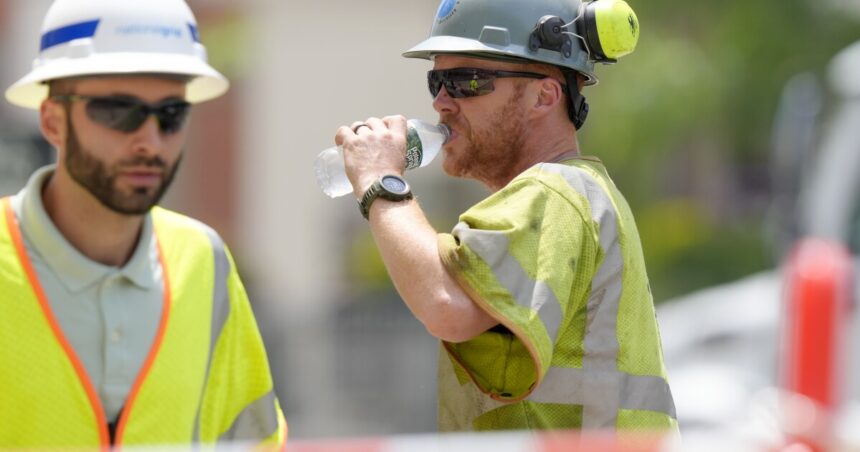As New England baked in a heat wave Thursday, guests at one campground were keeping their food and beer cold with blocks of ice harvested months earlier from a frozen lake.
And while some relief is expected in the eastern Great Lakes region and New England starting Friday, the National Weather Service said scorching temperatures will linger across the Ohio Valley and Mid-Atlantic region, and even rise in places, including California and Arizona, where they could eclipse 100 degrees Fahrenheit.
On Squam Lake in central New Hampshire, ice blocks about the size of microwaves that had been packed in sawdust since winter were lifted from an insulated storage hut. It’s been a tradition at the rustic Rockywold Deephaven Camps for more than a century, keeping fresh ice available throughout the summer and into the fall.
Angela Wilcox, who has vacationed at the camp for 16 years, took her children and nephews boating Thursday in search of the lake’s coldest swimming spot.
“This is the hottest it’s ever been, especially in June,” Wilcox said. “We’re kind of shocked.”
Heat index readings combining temperature and humidity were expected to surpass 100 degrees in many locations across the country, possibly setting some all-time records, the weather service said, and because record overnight temperatures could prevent natural cooling, heat danger could build up indoors.
“Those without access to reliable air conditioning are urged to find a way to cool down,” the service said in its forecast.
In a study published Thursday, a group of scientists said human-caused climate change has drastically increased the odds of experiencing the killer heat baking the Southwestern United States, Mexico and Central America this month. Last year, the U.S. recorded its most heat waves — abnormally hot weather lasting more than two days — since 1936.
Ocean waters are warmer as well, particularly in the Gulf of Mexico, where the season’s first named storm, Alberto, was dumping heavy rain and causing flash flooding along a stretch of the coast from Mexico to Louisiana. This year’s hurricane season is forecast to be among the most active in recent memory.
It’s made for an unusually early start to summer extremes in the northeastern U.S.
It was already nearing 90 degrees in New Hampshire as John Dupont opened his kettle corn stand at Concord’s 50th annual Market Days Festival. He and his daughter set up two fans and were prepared to drape icy towels around their necks.
“This year is a little challenging because of all the heat. Our kettle gets up to 150,000 BTUs,” he said.
At Johnson’s Dairy Bar in Northwood, Camryn Hildredth tried to offer customers an empty dish for that heartbreaking moment when a scoop of rapidly melting ice cream topples out of the cone, but not all would listen.
“Everybody asks if we have AC. We do not,” she said. “It’s very hot and we get long lines, so it can get very rough sometimes.”
In Burlington, Vermont, Jack Hurlbut said he’s never been so hot in his life. “I live in Vermont for a reason, you know what I mean?” the 28-year-old said.
Hurlbut, who is homeless, joined others in a shady spot on a lawn outside the public library, which was serving as a cooling center.
New York’s state parks had free admission Thursday, and select state-run pools and beaches opened early for swimming, Gov. Kathy Hochul said. New York City’s beaches were available, and although its public pools don’t open until next week, the city keeps a list of hundreds of free air-conditioned sites.
“The humidity is pretty insane,” said Anne-Laure Bonhomme, a health coach who was sightseeing in New York with her family.
Many school districts in New Jersey switched to early dismissals as the school year winds down, and at least two rescheduled their high school graduation ceremonies due to concerns about excessive heat and humidity.
With much of Indiana sweltering, highway crews are starting shifts at 6 a.m., two hours earlier than in cooler seasons, and taking more frequent breaks in air-conditioned trucks in between filling potholes and other roadwork, said Kyleigh Cramer, a spokesperson for the Indiana Department of Transportation.
“They’re able to get in those trucks and cool off right then and there because being out on the road is a little bit different than being in an office,” Cramer said.
Some relief is coming: A cold front is moving into areas near Lake Michigan later Thursday and on Friday, the weather service said. Chicago broke a 1957 record for June 17 on Monday, with a high of 97 degrees.
Related stories:
Rain brings new flash flood dangers to active wildfires in New Mexico





